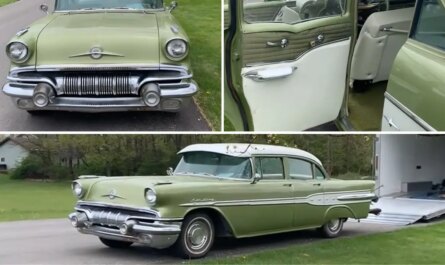When it comes to early 1960s Chevrolets, we usually think about the Impala and the Corvette. These are the company’s most iconic and sought-after nameplates from the era. However, Chevrolet had a pretty diverse lineup at the time, especially in the full-size car department.
The Impala was only the tip of the iceberg. Chevrolet also offered a somewhat premium Bel Air version and an entry-level Biscayne model. Apart from equipment and trim, all three looked pretty much the same and came with similar engine options.

But the full-size lineup wasn’t only about sedans, coupes, and convertibles. In 1960, the company had no fewer than four station wagons in showrooms. The Nomad was obviously the most luxurious and expensive, while the Brookwood sat at the bottom of the lineup. The Parkwood and Kingswood bridged the gap as mid-priced offerings. The former came with seating for six, while the latter included a three-bench, nine-person layout.
Not surprisingly, these grocery-getters don’t get a lot of attention nowadays. Sure, the Nomad is a bit more famous thanks to its Tri-Five days, but the Brookwood, Parkwood, and Kingswood are pretty much forgotten. And even though they were produced in relatively high numbers, they’re quite rare nowadays.

I don’t have precise numbers to run by, but nearly all the restored 1960 and 1961 full-size Chevys out there are Impalas and Bel Airs. On the flip side, most Biscaynes and station wagons are either rotting away in junkyards or locked away in barns with no second chance on the horizon.
For a classic wagon enthusiast like me, that’s a bummer. And that’s why I get excited whenever someone saves a grocery-getter, just like YouTube’s “Johnson Auto Ranch LLC” recently did with a 1961 Parkwood. But it’s not your typical rusty find. Even though it’s been sitting for a whopping 48 years, this wagon is still in one piece.

There’s no info about where it’s been parked all this time, but it looks like this Parkwood was luckier than the average abandoned classic. As in, it got a roof over its “head.” Sure, it’s not exactly rust-free, but it’s surprisingly clean for a vehicle that’s been neglected for a half-century. Additionally, most of its original blue paint is still visible. The patina is quite nice, too. I know a few people who would pay a lot of cash to have something like this recreated in a shop.
Why do I care so much about a Parkwood, a nameplate very few remember? Well, even though it’s not rare by production numbers, it’s a short-lived nameplate. Introduced in 1959, the Parkwood was discontinued at the end of the 1961 model year. Moreover, the 1961 version is a one-year gem (as are the Brookwood and Nomad wagons from the same model year).

Chevrolet sold nearly 169,000 grocery-getters in 1961, 137,300 of which were six-passenger vehicles like this one. However, only a few of them are still on the road, and possibly just a few hundred are still in one piece after decades of exposure to the elements. This 1961 Parkwood may not be valuable, but it’s definitely worth restoring. Or at least preserved as a rat rod with a more modern V8 under the hood.
Until that happens, check it out in the full walkaround below. Do you think it should be saved or parted out to help restore other vehicles from the era?



